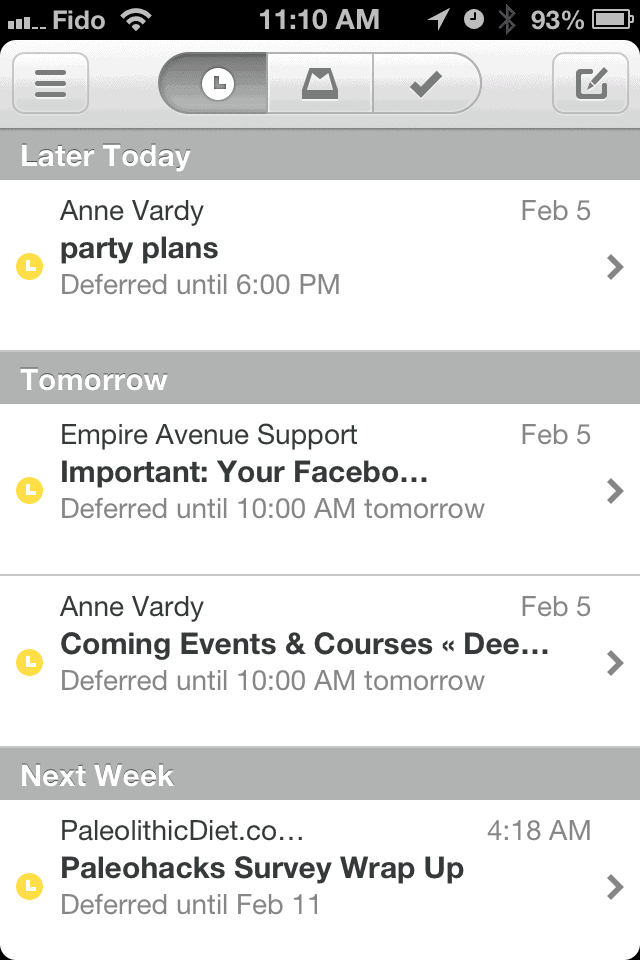

I managed to score early access to the new Orchestra-created mail app for iOS, Mailbox. The idea behind the app is to allow you to get to a point where you aren’t weighed down by your inbox – it allows you to use gestures and taps to turn your emails into actionable items (of sorts). For the most part, it does that very well. But I’m not convinced it’s the way people should go with email. So while Mailbox is very well-executed, it could hurt productivity more than help it.
By spending an inordinate amount of time in your email app, you are setting yourself up for a call-and-response environment. Email comes in at a decent pace, and focus is tough to achieve. With Mailbox, you can quickly get through your emails by either adding them to a list (there are several already in place and you can create custom lists as well), “snoozing” them (putting off dealing with them until later – and there are a wide variety of “laters” offered in Mailbox), or archiving/completing them on the spot. Using a user interface that is very reminiscent of Clear, Mailbox can really make processing email a much faster exercise.

The “snoozing” option is both a neat feature and an incredible procrastination device. You can “snooze” emails to be dealt with as follows:
- Later Today
- This Evening
- Tomorrow
- This Weekend
- Next Week
- In a Month
- Someday
- Pick Date
That’s a lot of options. This is where Mailbox really enters task management territory. This is also where the process of getting through your inbox slows down if you give when you’re going to revisit an email some thought. I think that Mailbox would work well in tandem with a paper planner of some sort at this juncture, because you essentially have a paper planner that has your non-email related tasks/actions on it, and then Mailbox handles your email-related ones. There’s bound to be crossover as well, but using both together will give you a better chance to avoid having things fall through the cracks.
(You can also change the settings for “snoozes” in the Settings function, including altering the start of your day, start of your weekends, end of workday, later today, and “someday” variables.)

There’s also the ability to move emails to lists, which is another great feature in that you can customize them. Lists essentially can act as contexts or as projects in Mailbox, so a savvy user could create lists for where they need to be to complete an activity, what project the email message is attache to, or who the email relates to. Again, since emails are often dealt with within the app there are limitations with location-based contexts, since the context most often used is going to be, well…email (or, as Orchestra hopes, Mailbox).

There are (of course) notification settings — and you can set the badge settings to three levels as well (actual emails needing attention, displaying a “1” when you have any emails needing attention, or no badge at all), which means you can be as connected to your email inbox as you want.
There have been a lot of reviews of this app already, so I won’t dive too much into the “how to” aspect more than I already have. While Mailbox does have its limitations, I have no doubt in my mind that the Orchestra team is going to bring in a few of the aspects of Orchestra To-Do into Mailbox somewhere down the line (I mean, they state as much in a recent blog post). That said, for those people using a task management application already, Mailbox really isn’t going to do all that much for them. In fact, it will probably take away from it more than anything else.
For those people who are yet to use any sort of task management app, Mailbox could be the gateway. I am not a fan of managing your tasks within your email app, but Mailbox is on the right track if that’s your thing. I think the next wave of productivity should focus more on the relationships then on the platform. That’s where an app like Cloze is more appealing to me than one like Mailbox. Mailbox does email and tasks, making it multidimensional in terms of how I process email and tasks. Cloze has become my communication hub, making it multidimensional in how I foster relationships. I’m more aligned with the latter than the former, because I use my task management app to help me direct my day. Email often puts someone else in the driver’s seat.
Email isn’t broken…how we use it is broken. I go as far to say that how we used it was never quite right in the first place. Mailbox is doing its part to help you get through your inbox by making task management within your email app more effective. Unfortunately, I don’t necessarily think that that is the way to go.1
If you do, however, get in line. There’s quite the queue in front of you.
1This idea, however, has got me curious.

